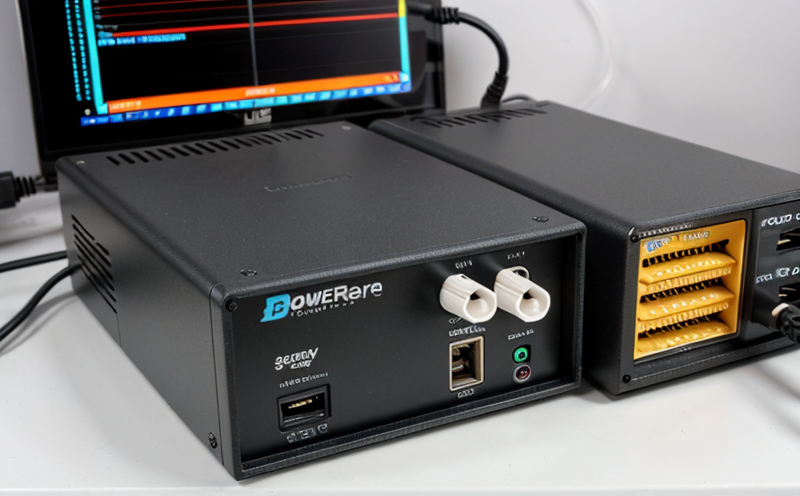IEEE 519 Harmonic Distortion Testing for Power Supplies
The IEEE Standard 519-2014 provides guidelines and requirements to limit the contribution of harmonic currents injected into utility power systems by nonlinear loads. This standard is particularly important in ensuring that equipment like power supplies and chargers do not cause adverse effects on the quality of electrical power distribution networks.
Harmonic distortion testing for power supplies aims to ensure compliance with IEEE Standard 519-2014, which specifies limits for harmonic current distortion caused by nonlinear loads. Nonlinear loads such as power supplies and chargers introduce harmonic currents into the power system, leading to higher-order voltage distortions that can affect the performance of other equipment connected to the same network.
Our testing service ensures that your power supply or charger meets these stringent standards. During this process, we use advanced instrumentation to capture detailed waveform data on the input and output voltages and currents. This helps identify any harmonic distortion present in the signal and assesses whether it falls within acceptable limits as defined by IEEE Standard 519-2014.
The testing procedure involves several steps:
- Installation of specialized equipment capable of capturing waveform data at various points on the power supply or charger.
- Data collection over a specified period to ensure comprehensive coverage of potential harmonic distortions.
- Analysis using specialized software to determine compliance with IEEE 519 standards.
- Reporting and certification upon successful completion.
The importance of this testing cannot be overstated, especially for manufacturers aiming to meet regulatory requirements or improve the reliability and efficiency of their products. By ensuring compliance with IEEE 519-2014, companies can enhance product performance while reducing potential risks associated with non-compliant devices.
| Parameter | Description | Units |
|---|---|---|
| Harmful Current Distortion | The percentage of harmonic content in the current waveform. | % |
| THD (Total Harmonic Distortion) | The ratio of total rms value of all harmonic currents to the fundamental frequency current. | % |
Scope and Methodology
The scope of our IEEE 519 Harmonic Distortion Testing for Power Supplies includes a comprehensive examination of both the input and output characteristics of power supplies and chargers. This ensures that any harmonic distortions generated by these devices are identified and addressed.
Our methodology involves:
- Setting up a dedicated test environment to replicate real-world conditions as closely as possible.
- Using state-of-the-art measurement equipment capable of accurately capturing even the smallest fluctuations in voltage and current.
- Conducting tests under different operating conditions, including rated load, light load, and no-load scenarios.
- Comparing measured data against IEEE 519-2014 requirements for harmonic distortion.
This approach guarantees that every aspect of the power supply or charger is thoroughly evaluated, providing a reliable assessment of its compliance with industry standards.
Benefits
The benefits of IEEE 519 Harmonic Distortion Testing for Power Supplies are numerous and far-reaching. By adhering to these stringent testing protocols, manufacturers can ensure that their products meet all necessary regulatory requirements while also improving overall system performance.
- Enhanced Reliability: Ensuring compliance with IEEE 519-2014 helps prevent potential failures caused by harmonics, thereby increasing the reliability of your power supply or charger.
- Better Efficiency: The testing process identifies and rectifies any inefficiencies in energy conversion that may be contributing to harmonic distortion.
- Compliance Assurance: By providing detailed reports and certifications, we help ensure that your product is compliant with all relevant international standards.
In addition to these direct benefits, there are also broader advantages for the environment and society at large:
- Reduction in Power Loss: Compliant devices contribute less to power losses on the grid, leading to more efficient energy usage.
- Better Quality of Service: Ensuring that your product does not introduce excessive harmonic distortions helps maintain a higher quality of electrical service for everyone connected to the same network.
Industry Applications
This testing is particularly relevant in various sectors where power supplies and chargers are used extensively. These include:
- Consumer Electronics:
- Telecommunications:
- Automotive:
- Medical Devices:
- Data Centers:
| Sector | Main Use Cases |
|---|---|
| Consumer Electronics | Ensuring that portable devices like smartphones and laptops do not introduce excessive harmonic distortion into the power grid. |
| Data Centers | Improving the efficiency of servers and IT equipment, which often draw significant amounts of power from multiple sources. |





